
c2c is a British train operating company owned by Trenitalia that operates the Essex Thameside railway contract. It manages 25 stations and its trains call at 28. c2c provides commuter services from its London Fenchurch Street terminus to parts of East London and south Essex along the London, Tilbury and Southend line. At weekends it also operates from London Liverpool Street.

The Great Eastern Main Line is a 114.5-mile (184.3 km) major railway line on the British railway system which connects Liverpool Street station in central London with destinations in east London and the East of England, including Shenfield, Chelmsford, Colchester, Ipswich and Norwich. Its numerous branches also connect the main line to Southminster, Braintree, Sudbury, Harwich and a number of coastal towns including Southend-on-Sea, Clacton-on-Sea, Walton-on-the-Naze and Lowestoft.

The London, Tilbury and Southend line, also known as Essex Thameside, is a commuter railway line on the British railway system. It connects Fenchurch Street station, in central London, with destinations in east London and Essex, including Barking, Upminster, Basildon, Grays, Tilbury, Southend and Shoeburyness.

The British Rail Class 357Electrostar are alternating current (AC) electric multiple unit passenger trains (EMUs) built by Adtranz at its Derby Litchurch Lane Works, England, in two batches from 1999 to 2002 at a cost of approximately £292 million.

The British Rail Class 360 Desiro is an electric multiple unit class that was built by Siemens Transportation Systems between 2002 and 2005. The Class 360 is currently operated by East Midlands Railway and the Global Centre of Rail Excellence.

The British Rail Class 317 is an electric multiple unit (EMU) passenger train constructed by British Rail Engineering Limited in two batches: 48 sets were produced in 1981–82 and 24 sets in 1985–87. They were the first of several classes of British Rail EMU to be based on the all-steel Mark 3 bodyshell, departing from the PEP-aluminium design which had spawned the earlier Class 313 to Class 315, Class 507 and Class 508. The Mark 3 bodyshell was also the basis of Class 318, Class 455 and the diesel Class 150. The Class 317 uses overhead alternating current electrification. All units were withdrawn in July 2022.
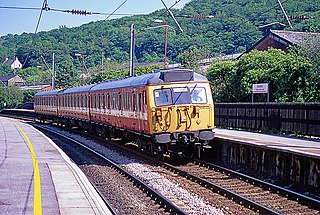
The British Rail Class 308 alternating current (AC) electric multiple units (EMU) were built by British Railways' Holgate Road carriage works in three batches between 1959 and 1961. They were initially classified as AM8 units before the introduction of TOPS.
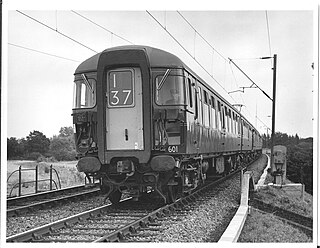
The British Rail Class 309 "Clacton Express" electric multiple units (EMUs) were built by British Rail (BR) York Carriage Works from 1962–1963. They were initially classified as Class AM9 before the introduction of TOPS. These units were the first express 25 kV alternating current (AC) units to be built by British Rail and were their first EMUs capable of 100 mph.
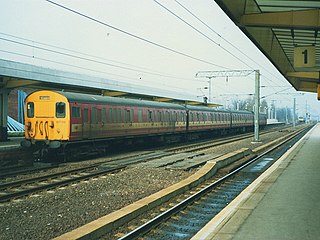
The British Rail Class 307 electric multiple units were built by BR at Eastleigh Works from 1954 to 1956. They were initially classified as AM7 before the introduction of TOPS.

The British Rail Class 321 is a class of electric multiple unit (EMU) passenger train built by British Rail Engineering Limited's York Carriage Works in three batches between 1988 and 1991 for Network SouthEast and Regional Railways. The class uses alternating current (AC) overhead electrification. The design was successful and led to the development of the similar Class 320 and Class 322.

The British Rail Class 508 (4PER) is a type of electric multiple unit (EMU) passenger train built by British Rail Engineering Limited, at Holgate Road carriage works, York, in 1979 and 1980. They are a variant of British Rail's standard 1972 design for suburban EMUs, eventually encompassing 755 vehicles and five classes (313/314/315/507/508). They mostly worked on the Merseyrail network from 1983 until withdrawal.

The British Rail Class 310 was a slam-door, alternating current (AC) electric multiple unit (EMU) introduced in 1965 as part of the West Coast Main Line electrification project. They were initially classified as Class AM10 units before the introduction of the TOPS classification system. Constructed at BR's Derby Carriage and Wagon Works. They consisted of four carriages - a second class driving trailer, a second class trailer, a second class motor car and a composite driving trailer. The maximum speed was 75 miles per hour (121 km/h). A glass partition behind the driver's cab enabled passengers in the leading and rear coaches to view the line ahead or behind.

The British Rail Class 315 is a fleet of alternating current (AC) electric multiple unit (EMU) trains, built by British Rail Engineering Limited at Holgate Road Carriage Works in York between 1980 and 1981; they replaced the Class 306 units. It was a variant of unit derived from British Rail's 1971 prototype suburban EMU design which, as the BREL 1972 family, eventually encompassed 755 vehicles across Classes 313, 314, 315, 507 and 508. Revenue services with Class 315 units commenced in 1980 and continued until December 2022.
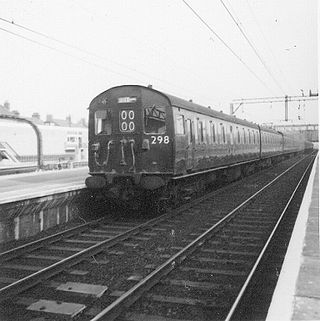
The British Rail Class 302 was a type of electric multiple unit (EMU) introduced between 1958 and 1960 for outer suburban passenger services on the London, Tilbury and Southend line. This class of multiple unit was constructed using the Mark 1 bodyshell and was slam-door.
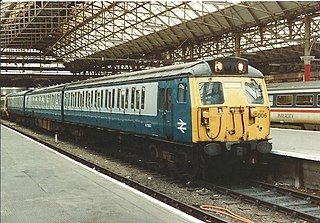
The British Rail Class 304 were AC electric multiple units designed and produced at British Rail's (BR) Wolverton Works.

The British Rail Class 305 was an alternating current (AC) electric multiple unit (EMU). Under the pre-1973 British Rail numbering system, the class was known as AM5; when TOPS was introduced, it became Class 305.

The British Rail Class 379 Electrostar is an electric multiple unit (EMU) passenger train which was designed and built by Bombardier Transportation. The trains are part of the company's extensive Electrostar family.

Network SouthEast (NSE), the sector of British Rail which ran passenger services in London and southeast England between 1986 and 1994, operated a wide variety of rolling stock during its existence. The majority of the network was electrified, and further electrification schemes took place during the 1986–1994 period; and the 7,000 vehicles owned by NSE in 1986 consisted of a mixture of electric, diesel-electric and diesel multiple units, diesel locomotives and the coaches they hauled.
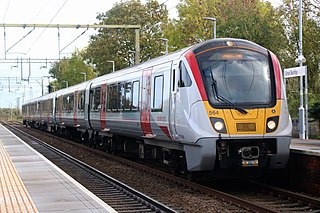
The British Rail Class 720 Aventra is a class of electric multiple unit (EMU) passenger train designed and produced by the rolling stock manufacturer Bombardier Transportation and Alstom. Orders for the type have been placed by both Greater Anglia and c2c.





















